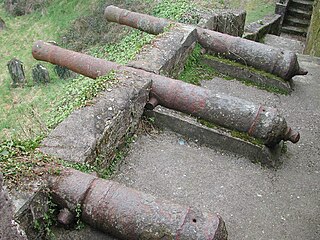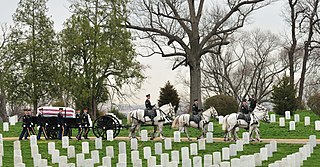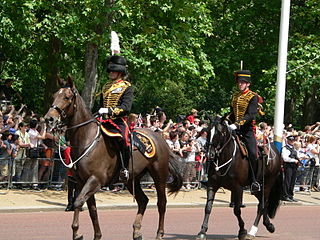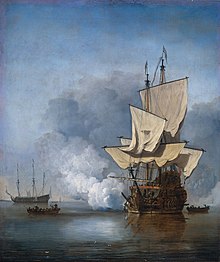
A state visit is a formal visit by a head of state to a foreign country, at the invitation of the head of state of that foreign country, with the latter also acting as the official host for the duration of the state visit. Speaking for the host, it is generally called a state reception. State visits are considered to be the highest expression of friendly bilateral relations between two sovereign states, and are in general characterised by an emphasis on official public ceremonies.

The Battle of Fort Sumter was the bombardment of Fort Sumter near Charleston, South Carolina by the South Carolina militia. It ended with its surrender by the United States Army, beginning the American Civil War.

In military organizations, an artillery battery is a unit or multiple systems of artillery, mortar systems, rocket artillery, multiple rocket launchers, surface-to-surface missiles, ballistic missiles, cruise missiles, etc., so grouped to facilitate better battlefield communication and command and control, as well as to provide dispersion for its constituent gunnery crews and their systems. The term is also used in a naval context to describe groups of guns on warships.

A military funeral is a memorial or burial rite given by a country's military for a soldier, sailor, marine or airman who died in battle, a veteran, or other prominent military figures or heads of state. A military funeral may feature guards of honor, the firing of volley shots as a salute, drumming and other military elements, with a flag draping over the coffin.

A 21-gun salute is the most commonly recognized of the customary gun salutes that are performed by the firing of cannons or artillery as a military honor. As naval customs evolved, 21 guns came to be fired for heads of state, or in exceptional circumstances for heads of government, with the number decreasing with the rank of the recipient of the honor. While the 21-gun salute is the most commonly recognized, the number of rounds fired in any given salute will vary depending on the conditions. Circumstances affecting these variations include the particular occasion and, in the case of military and state funerals, the branch of service, and rank of the person to whom honors are being rendered.

A riderless horse is a single horse without a rider and with boots reversed in the stirrups, which sometimes accompanies a funeral procession. The horse, sometimes caparisoned in black, follows the caisson carrying the casket. A riderless horse can also be featured in parades to symbolize either fallen soldiers, fallen police officers or deceased equestrian athletes. A motorcycle can be used as a substitute for a horse though such practice is very rare.

The King's Troop, Royal Horse Artillery, is a ceremonial unit of the British Army, quartered at Woolwich. It is a mounted unit and all of its soldiers are trained to care for and drive teams of six horses, each team pulling a First World War-era QF 13-pounder gun; six teams are used in the unit's Musical Drive. The Troop's duties include firing salutes on royal and state occasions, participation in parades, and the duties of the King's Life Guard at Horse Guards for one month each year. The unit provides the gun carriage and team of black horses for state funerals. The unit is most often seen providing gun salutes on state occasions in Hyde Park, and Green Park.

The 3rd United States Infantry Regiment is a regiment of the United States Army. It currently has three active battalions, and is readily identified by its nickname, The Old Guard, as well as Escort to the President. The regimental motto is Noli Me Tangere. The regiment is a major unit of the Military District of Washington (MDW). The 3rd Infantry is the oldest regiment still active in the Regular Army, having been first organized as the First American Regiment in 1784. It has been the official ceremonial unit of the U.S. Army since 1948.

The United States Army Military District of Washington (MDW) is one of nineteen major commands of the United States Army. Its headquarters are located at Fort Lesley J. McNair in Washington, D.C. The missions of the units in the Military District of Washington include ceremonial tasks as well as a combat role in the defense of the National Capital Region.

A feu de joie is a form of formal celebratory gunfire consisting of a celebratory rifle salute, described as a "running fire of guns." As soldiers fire into the air sequentially in rapid succession, the cascade of blank rounds produces a characteristic "rat-tat-tat" effect. It is used on rare landmark occasions of national rejoicing. During the 18th and 19th centuries, a feu de joie has celebrated a military victory or birthday. In recent years, it has marked, in Royal presence, the 80th Birthday and Diamond Jubilee of Queen Elizabeth II, as well as the Death of Queen Elizabeth II. Feux de joie also mark annual national or army days in, e.g., Canada, Malta, Nepal and Singapore.

The Ordnance QF 13-pounder (quick-firing) field gun was the standard equipment of the British and Canadian Royal Horse Artillery at the outbreak of World War I.

The QF 3-pounder Hotchkiss or in French use Canon Hotchkiss à tir rapide de 47 mm were a family of long-lived light 47 mm naval guns introduced in 1886 to defend against new, small and fast vessels such as torpedo boats and later submarines. There were many variants produced, often under license which ranged in length from 32 to 50 calibers but 40 caliber was the most common version. They were widely used by the navies of a number of nations and often used by both sides in a conflict. They were also used ashore as coastal defense guns and later as an anti-aircraft gun, whether on improvised or specialized HA/LA mounts.

In the United States, state funerals are the official funerary rites conducted by the federal government in the nation's capital, Washington, D.C., that are offered to a sitting or former president, a president-elect, high government officials and other civilians who have rendered distinguished service to the nation. Administered by the Military District of Washington (MDW), a command unit of the Joint Force Headquarters National Capital Region, state funerals are greatly influenced by protocol, steeped in tradition, and rich in history. However, the overall planning as well as the decision to hold a state funeral, is largely determined by a president and their family.

The 206th Field Artillery Regiment is a United States artillery regiment, currently represented in the Arkansas Army National Guard by the 1st Battalion, 206th Field Artillery, Headquartered at Russellville, Arkansas. The 1–206th FA is an element of the 39th Infantry Brigade Combat Team.

The Mexican Armed Forces have a number of bugle and trumpet calls for the different branches. Drums and bugles are used to signal the various calls for most units of the Army, Navy and Air Force while the cavalry trumpet is used to signal calls for the cavalry units of the Army, Army artillery units and the Air Force. Many of the calls and signals listed below are also used by civilian drum and bugle bands.

A military funeral in the United States is a memorial or burial rite conducted by the United States Armed Forces for a Soldier, Marine, Sailor, Airman, Guardian or Coast Guardsman who died in battle, a veteran, or other prominent military figures or a president. A military funeral may feature guards of honor, the firing of volley shots as a salute, drumming and other military elements, with a flag draping over the coffin.

St. David's Battery, also known during wartime as the "Examination Battery", was a fixed battery of rifled breech-loader (RBL) artillery guns, built and manned by the Royal Garrison Artillery and the Royal Engineers, and their part-time reserves, the Bermuda Militia Artillery and the Bermuda Volunteer Engineers, part of the Bermuda Garrison of the British Army.

The Saluting Battery is an artillery battery in Valletta, Malta. It was constructed in the 16th century by the Order of Saint John, on or near the site of an Ottoman battery from the Great Siege of Malta. The battery forms the lower tier of St. Peter & Paul Bastion of the Valletta Land Front, located below the Upper Barrakka Gardens and overlooking Fort St. Angelo and the rest of the Grand Harbour.

The Presidential Salute Battery, an element of the 3rd United States Infantry Regiment, comprises soldiers qualified as MOS 11C (Mortarman). This battery primarily handles firing ceremonial gun-salute honors at general officer funerals, retirements, state occasions, and provides indirect fire support for the regiment's tactical operations.

On November 30, 2018, George H. W. Bush, the 41st president of the United States, died from vascular Parkinson's disease at his home in Houston, Texas. Bush was the first former U.S. president to die in nearly 12 years since Gerald Ford in late 2006. At the age of 94 years, 171 days, Bush was the longest-lived U.S. president in history at the time of his death, a record which was surpassed by Jimmy Carter on March 22, 2019; both were born in the same year (1924).





















